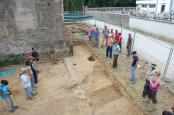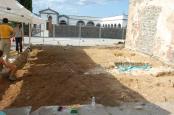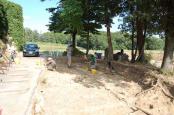CAMPAGNA 2012 |
1° SETTIMANA |
2° SETTIMANA |
3° SETTIMANA |
4° SETTIMANA |
5° SETTIMANA |
6° SETTIMANA |
16 LUGLIO 2012 
Resoconto della giornata di scavo
Area 1000
Continua la rimozione degli strati superficiali nella porzione Nord-Est dell’area di scavo, contenenti materiale ceramico molto recente. Al di sotto di questi sembra comparire una complessa situazione stratigrafica caratterizzata da grandi tagli regolari ed orientati in senso Nord-Sud. Analizzando poi i rapporti stratigrafici relativi alla struttura muraria US 1018 si nota come questa sia intercettata dal taglio US -1133. Considerando che il materiale ceramico contenuto nel suo riempimento è databile al XVIII secolo, avremmo una prima datazione relativa alla struttura muraria che risulterebbe anteriore a questa data.
Today, in area 1000, we completed the
excavation of the drainage trench. The trench was then photographed. Excavation
in the area immediately surrounding the ossuary discovered in the 2011 field
season began. In the northeast quadrant of the area, more topsoil and debris
layers were removed to expose the yellow clay underneath. This same soil layer
has been found in channels cut in adjacent areas. Another debris section on the
south side of the destructed wall has started to be excavated; again removing
the dirt down to the yellow clay layer below.
Area 2000
Procede la documentazione presso l’allargamento settentrionale nel Settore A. Dopo la rimozione di US 2009, è stato messo in luce lo strato US 2011 che fin dall’anno precedente si caratterizzava come la prima vera fase cimiteriale, su cui insistevano i primi individui in connessione ben preservati. Seppur ancora poco dettagliata, l’indagine conferma la presenza di numerose ossa, molte non in connessione, fatta eccezione probabilmente per due crani ravvicinati tra di loro e collocati subito ad Ovest della struttura laterizia (US 2100); il più occidentale vede intorno diverse lastrine inserite all’interno di quello che potrebbe risultare un taglio di fossa sepolcrale. Presso il Settore B è iniziata la rimozione di US 2221 che riempie un taglio allungato di forma ellissoidale e collocato al centro del settore stesso; all’interno sono state rinvenute alcune ossa animali, frammenti di ceramica ottocentesca ed una moneta in bronzo che permetterebbe di datare l’unità stratigrafica in questione alla fine del XVII secolo.
Today was a great day! Veronica continued
excavating the skeleton (Us 2193) on the south side of Area 2000 Sector A. She was able to finish by
taking out the rest of the ribs and finally getting to the vertebrae from the
soil. Some of the vertebrae were fused which could indicate a pathological
disease, possibly scoliosis. Alexa, Molly, and Claire found a change in color
and composition, they were able to find a fill in Sector B. They dug about a half of a meter and found glass, a coin
from the 18th Century, animal bone and teeth and 4 nails. They also found what
they thought was a pottery shard but ending up being part of a roof tile that
is made to catch water. Adam was moved to Sector
A and started to remove layer 2009. He found a deciduous tooth, and will
map out the structure that is made of mortar and brick with the total station.
The goal is to get down to layer US 2011. In layer US 2011 there
are two cranium next to the brick structure that need to be looked at to
determine if it is a true burial, and also if one of the skeletons is in
connection. Walker removed the fill US 2205 and then moved to the GIS
lab. He learned how to use the total station and then mapped out a trench that
is in Area 1000. After, they took pictures and uploaded them to the computer
and used Autocad and GIS to create an image in space of the actual trench.
Area 3000
Nella giornata di oggi si è proceduto alla pulizia generale dell’area, in particolare dell’ampliamento ovest, i cui limiti sono stati documentati e rettificati. L’accurata ed attenta rimozione dello strato immediatamente al di sotto del manto stradale superficiale caratterizzato da asfalto e ghiaia ha permesso la messa in evidenza dei livelli cimiteriali sia tardo medievali (nel Settore A, a nord del muro US 3073), sia di quelli databili attorno al XVII secolo (nel Settore B, a sud di US 3073). In particolare nell’ampliamento del Settore A sembra emergere, nella porzione centrale, uno strato termotrasformato, con tracce di fuoco, carbone e scorie metalliche, ancora in corso di scavo; nel Settore B, lungo il margine S-W dell’area, si intravedono alcune ossa parzialmente in connessione, in particolare gli arti inferiori probabilmente appartenenti ad un individuo infantile e, immediatamente ad ovest, il cranio di un individuo adulto. Nei giorni seguenti ulteriori indagini potranno chiarire ulteriormente questa situazione. Sempre nel Settore B durante lo scavo sono stati rinvenuti alcuni oggetti di corredo molto interessanti, in particolare un’applique in bronzo utilizzata per chiudere le vesti, un bottone in madreperla, un rosario con un crocifisso bronzeo ancora attaccato alla catenina, due monete (1 centesimo e 5 lire) che riportano rispettivamente le date 1904 e 1920, e due anelli, di cui uno a fascia e l’altro decorato con un motivo a treccia, riferibili probabilmente al XVIII-XIV secolo.
Today as the entire
group cleaned the recently cleared section we came across various objects and
skeletal material including two rings, a rosary with attached chain, a button, a
dress clip, a coin, pieces of glass, pottery shards, nails, and teeth. Dr. Larsen
also arrived on site today and preventions were given. Towards the end of the
day, the entire site was sprayed with water and leveled as a final cleaning
effort. Frank spent the day in the bone lab.
Area 4000
Nella giornata di oggi abbiamo continuato la pulizia di US 4070. Lo scavo della vasca per la malta (US 4079) ha permesso di rinvenire un osso lungo animale assieme a 4 grossi pezzi di ceramica. Abbiamo continuato a pulire il riempimento US 4067 e abbiamo trovato ossa non umane. Abbiamo finito di scoprire il tubo in PVC moderno che taglia in due l'area 4000, ottenendo così due distinti bacini stratigrafici. Infine, abbiamo continuato a pulire e spiombare la parete nord dell’area. Molti pezzi di ceramica sono stati scoperti nel muro, che tuttavia non possono essere inseriti in un contesto specifico che dunque non può essere registrato. La cosa più interessante che abbiamo trovato è stato il 40% di una ciotola di ceramica che risale al 1600 circa e sembra provenire dal Valdarno tra Firenze e Pisa.
Today on July 16th, 2012 in area 4000, we
continued cleaning US 4070. We cleaned US 4079, a mortar pit, and while
doing so found what is most likely a nonhuman long bone. In addition, we found
4 large pieces of pottery. We continued cleaning out the mortar pit (US 4067)
and we found a second non human bone. We finished uncovering and cleaning the
area around the modern PVC pipe that bisects the area 4000, realizing the
definitive separation in soil contexts. Finally, we continued to clean and
straighten the northern wall of area 4000. Several pieces of ceramics were
discovered in the wall, but since we cannot place them in a specific context
they may not be recorded. The most interesting thing we
found was 40% of a ceramic bowl dating circa 1600s and originating from the
area between Florence and Pisa.















